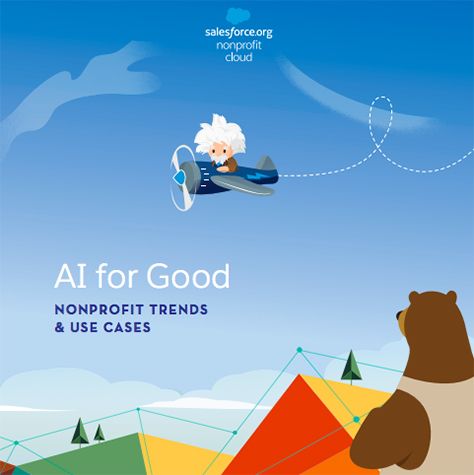
Salesforce.Org recently published an e-book, AI for Good: Nonprofit Trends & Use Cases. It is a good primer for nonprofits (non-techies) who want to understand what the heck AI is and how it might be useful to their nonprofit.
Just a few insights:
- AI is already part of your life, although it might be invisible to the end user. AI makes your daily experience smarter, by embedding predictive analysis into everyday apps. For example, Facebook has been using AI with facial recognition to recommend who should be tagged on your photos or when you purchase something on Amazon, it is using machine learning algorithms to recommend other products.
- The key ingredients to make AI work: Data (clean, complete, unbiased); Tools (computers & software), and Algorithms (set of rules to analyze the data.) AI works more quickly and efficiently than humans in analyzing patterns in large datasets to provide insights. AI algorithms have to be trained by categorizing the dataset.
- There are many speciality areas for AI. Three more familiar areas include Machine learning, Deep Learning, and Natural Language Processing (the code that translates the data into conversations and use for chat bots, robots, and virtual personal assistants).
- On a big picture level, nonprofits should also be part of the conversation about AI and society – and how it impacts the people they serve as well as defining how it can beneficial to the social sector. Questions such as how can AI algorithms be optimized to improve the lives of at-risk or vulnerable populations and other questions need to be addressed by non-technical people working alongside data scientists, engineers and algorithm coders. The report links to the Salesforce.org blog post on Principles for AI for Good.
- Many nonprofits are wondering how AI can help them. The report adapts a set a framework by Christopher Noessel, designer for the Watson Customer Experience team at IBM focusing on interaction with AI. The framework is a set questions around these concepts: Prepare, Optimize, Advise, Automate, Reduce, and Finish and provides an example of the questions to ask around designing a virtual assistant. For a more specific list of benefits for nonprofits, see this list, that outlines some of the big picture questions.
- The report gives examples of how AI can be used in different nonprofit contexts using the Salesforce product Einstein. The product allows you to build AI predictive models based on data in your CRM for fundraising, programs, and engagement. The engagement predictive models allow a nonprofit to determine, for example, how likely someone was to open an email and segment people in your CRM based on that. The examples in the report share basic starting points for nonprofits. The report includes a list of more advanced uses of AI by nonprofits, all tasks that the Einstein is capable of doing.
- The reports addresses ethical considerations and what nonprofits need to know. It summarizes ten tips that can help ensure that a nonprofit is using it responsibly by building out the right team and internal processes. Most importantly, it begins with cultivating a ethical mindset — there is a lot that you can do with AI, but should you? Also, important to give your stakeholders control of their data, respect their privacy, and protect at-risk populations.
- AI is here now and while there are practical and simple ways that nonprofits can apply it, we need to also be aware of the bigger picture around the impact on civil society – an in particular making sure that we are active advocates around “AI4Good.”
Is your nonprofit having a conversation internally about how it might use AI4Good for your programs, operations, marketing or fundraising?

Leave a Reply